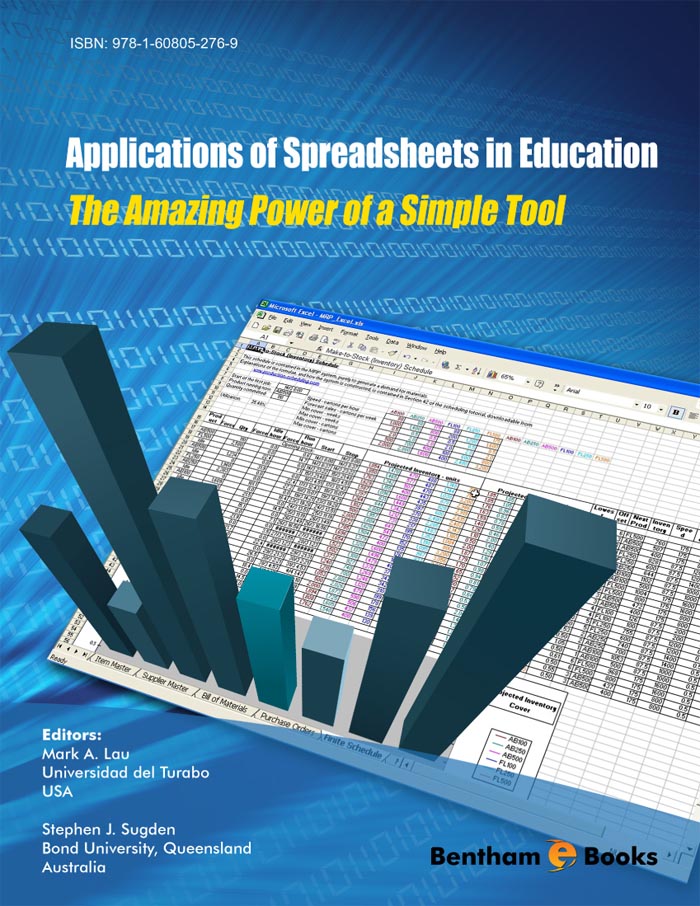This e-book is devoted to the use of spreadsheets in the service of education in a broad spectrum of disciplines: science, mathematics, engineering, business, and general education. The effort is aimed at collecting the works of prominent researchers and educators that make use of spreadsheets as a means to communicate concepts with high educational value.
Spreadsheets have been around since the late 70s. They were initially conceived as office productivity tools, most notably in accounting applications. Over time, spreadsheets evolved to incorporate a wealth of functions to appeal to the scientific community. Applications of spreadsheets in different branches of science and engineering are continually being reported in many scholarly journals.
In recent years, a shift in learning paradigms towards a more constructivist education has incited researchers and educators to find new approaches to education in science, mathematics, and engineering. This trend is not confined to the USA only, but it seems that it is more widespread around the globe. It is in this context, that applications of spreadsheets in education, from primary to university levels, are gaining marked prominence, as evidenced by the number of journal publications and presentations at technical conferences.
This e-book brings some of the most recent applications of spreadsheets in education and research to the fore. We assume that the reader is already familiar with the basics of electronic spreadsheets. To offer the reader a broad overview of the diversity of applications, carefully chosen examples from different areas have been included. Applications have been organized in four parts, each containing three chapters:
-
Part I: Engineering
Chapter 1 presents fault analysis in power systems, a common topic in power system courses. Symmetrical and unsymmetrical short circuit currents are computed using a spreadsheet. The determination of these currents provides valuable information for selecting the appropriate protection equipment in a power system.
Chapter 2 shows how to implement spreadsheets for structural analysis. The topic is relevant to many branches of engineering, namely, civil, mechanical, aerospace, and structural engineering. Spreadsheet models for analyzing beams, walls, frames, and multi-degree-offreedom systems are presented.
Chapter 3 discusses optimal control of dynamical systems. The minimum principle of Pontryagin and the numerical solution of differential equations are illustrated with spreadsheets. In addition, an interesting example motivated by research (control of a flexible structure via command shaping) is presented in this chapter.
-
Part II: Mathematics and Sciences
Chapter 4 illustrates modular arithmetic, a topic that is relevant to mathematicians and computer scientists. This chapter makes use of the conditional formatting of spreadsheets to reveal interesting patterns in modular arithmetic.
Chapter 5 presents computational problem solving in context. In this chapter, some amusing problems involving difference equations, number sequences, and polygon-like numbers are solved with the help of spreadsheets.
Chapter 6 introduces enzyme kinetics to chemistry, biology, and biochemistry students. This chapter includes the kinetics of enzyme reactions, linear and non-linear regression analyses, experimental error, and the effects of inhibitors.
-
Part III: Management Sciences
Chapter 7 describes a project management gaming application. The project management game is designed as a teaching tool to allow players to experience project management in an interactive and fun atmosphere. The game exposes players to project planning, budgeting, resource allocation, decision making, and many other aspects of IT projects in a very realistic manner.
Chapter 8 introduces mean-variance portfolio theory, which is part of the core curriculum of modern finance in business education. In particular, this chapter presents an asset pricing model in an equilibrium setting. Several spreadsheet features in matrix operations are used to illustrate the computational task involved.
Chapter 9 presents a research study on the innovation diffusion model and the life cycle of a high technology product applied to the sales of modems from 1994–2009, including successive generations of modems: 14.4k, 28.8k, 56k, broadband less than 3.6Mbps, and broadband greater than 3.6Mbps. The model is used by managers to understand the development of new products and their life cycle.
-
Part IV: General Education
Chapter 10 exploits the graphical capabilities of spreadsheets to enhance the teaching and learning of school mathematics. Topics presented in this chapter include introductory calculus, functions, linear algebra, conics, and stereometry.
Chapter 11 reports a research study on the use of technical software, including spreadsheets, by graduates of actuarial studies programs in Australia. The chapter suggests some implications for universities wishing to design curriculum to prepare students for careers in the financial services industry.
Chapter 12 presents a case study illustrating the physical dispatch algorithm used by Australia’s electricity market operator (AEMO) to determine which power plants to dispatch into the grid and the resultant electricity spot price. The spreadsheet model presented in this chapter is used in professional development workshops.
Some of these applications make use of Visual Basic for Applications (VBA), a versatile computer language that further expands the functionality of spreadsheets.
The chapters contained herein were contributed by prominent researchers and educators who made creative use of spreadsheets as a research, teaching, and/or learning tool. The reader can download the spreadsheet models presented in this e-book from the publisher's website. The breadth of applications will provide the reader with a fresh look at the amazing power and the simplicity of spreadsheets and the VBA programming environment. We hope that the material included in this e-book will inspire readers to devise their own applications and enhance their teaching and/or learning experience, and share our passion for spreadsheets.
Acknowledgments
First and foremost, we wish to acknowledge our great debt to our contributors for sharing their expertise. We are grateful to the following people for their valuable comments and diligence in reviewing this e-book: John Baker (Natural Maths, Australia), Oscar Chavez (Mathematics Education Program, University of Missouri, USA), Greg Cranitch (School of Information Technology, Bond University, Australia), Marjorie Darrah (Department of Mathematics, West Virginia University, USA), Neville de Mestre (Emeritus Professor, School of Information Technology, Bond University, Australia), Therese Donovan (Vermont Cooperative Fish and Wildlife Research Unit, University of Vermont, USA), Adrian Gepp (School of Business, Bond University, Australia), Kieran Lim (School of Biological and Chemical Sciences, Deakin University, Australia), Thomas Overbye (Department of Electrical and Computer Engineering, University of Illinois at Urbana-Champaign, USA), Malcolm Peck (Managing Director, The Carnot Group, Australia), Warren Richards (Head of Department of Mathematics, Moreton Bay College, Australia), Vladimir Romanenko (North Western Institute of Printing, St. Petersburg State University of Technology and Design, Russia), Geoff Smith (Department of Mathematics, University of Technology, Sydney, Australia), Michael Steele (Faculty of Business, Division of Economics and Statistics, Bond University, Australia), and to the anonymous peer reviewers appointed by Bentham Science Publishers. We also want to thank Salma Sarfaraz and Hina Wahaj of Bentham for their assistance in making this project a success.
Mark Lau
Universidad del Turabo, Puerto Rico, USA
mlau@suagm.edu
Stephen Sugden
Bond University, Queensland, Australia
ssugden@bond.edu.au





